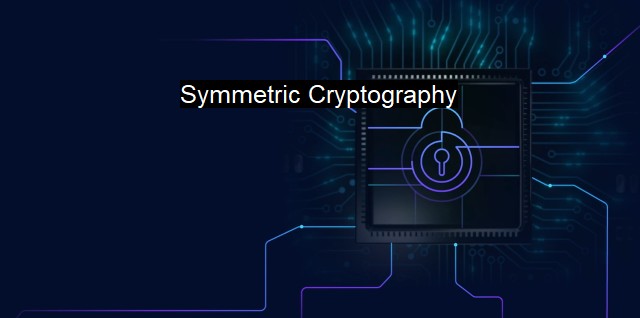What is Symmetric Cryptography?
The Power of Symmetric Cryptography in Today's Cyber World: Understanding and Implementing Robust Encryption Measures to Protect Confidential Information
Symmetric cryptography is a paramount aspect of cybersecurity that focuses on the encryption and decryption of data to ensure its secure transmission over the internet. It is often referred to as secret key cryptography because the same key is used for both the encryption and decryption of information. Server-client interaction on the internet, accessing one's e-mail, or transacting with an online store are some examples where this type of cryptosystem is employed. Fundamentally, it revolves around the tenet of maintaining confidentiality through secure communication channels, preventing unauthorized access, providing data integrity, and verifying data origination.In symmetric cryptography, both the sender and the receiver use the same shared key for both encryption and decryption. This means that before secure communication can take place, the sender and the recipient must agree on the key that will be used to secure the data in transit. The message to be sent is transformed into an unreadable format using encryption algorithms employing the secret key. The decryption process uses the identical secret key to reverse the complicated algorithmic transformation and regain the original message.
In terms of secrecy, symmetric encryption provides a high level of security due to the need for a secret key. Besides, it stands out for its speed and efficiency when encrypting large volumes of data, making it suitable for diverse applications. This is perfectly cohesive in Real-Time Operating Systems (RTOS), ensuring compact, swift, and well-performing software execution.
The integrity of symmetric cryptography is corroborated through its mathematical transformations that are challenging for cybercriminals to decipher. Although the key management issue poses a problem in terms of securely sharing the key among users, solutions like secure key distribution using public key cryptography provide a remedy.
To render further protection, symmetric cryptography is often complemented with antivirus systems to ensure an advanced level of cybersecurity. Antivirus software hinges on the ability to detect and block malicious activities such as viruses, Trojans, and worms that threaten the integrity and security of the system. It leverages various methodologies such as signature-based detection, machine learning, behavioral analysis, and sandboxing.
The antivirus protects the system's data to reduce the potential of falling prey to unauthorized access, manages vulnerability scanning, and logs analysis against known potential issues. It keeps the systems clean of malware, observing programs and files for any suspicious activity, including attempts from external sources trying to get through firewalls or crack cryptographic procedures.
Combining an antivirus system with symmetric cryptography forms a significant part of the defense-in-depth strategy in cybersecurity. While antivirus software offers an extra layer of security to end devices and networks, symmetric cryptography provides data security and privacy between sender and receiver. By protecting the main communication channels, symmetric encryption substantially diminishes the risk of sensitive data theft during data transmission, a scourge that continues to be a major concern in the digital age.
While symmetric key cryptography has constraints such as the key distribution problem and a single point of failure, contributed by the dependence on one key, its faster processing capabilities compared to asymmetric encryption and aptness in a spectrum of applications still make it an invaluable resource in protecting digital jurisdictions today. its ability to maintain data secrecy, integrity, and privacy lends significantly to its substantial defense contribution, particularly when used in synergy with antivirus technology.
Symmetric encryption forms the backbone of multiple features inherent with its focus on secure communication and information integrity. It shields against illegal data access that could be harnessed for malintent. Combined with antivirus software, symmetric cryptography plays a substantial role in building a resilient digital space secure from multi-vector attacks from today's sophisticated cyber threats.

Symmetric Cryptography FAQs
What is symmetric cryptography?
Symmetric cryptography is a type of encryption system that uses the same key for both encryption and decryption of data. It is also known as secret-key cryptography, where the sender and receiver share a secret key that is used to encrypt and decrypt messages.How is symmetric cryptography used in cybersecurity?
Symmetric cryptography is used in cybersecurity to protect confidential data from unauthorized access or interception. It ensures that only the intended recipient can decrypt and access the data. It is often used in conjunction with other security measures such as firewalls and antivirus software to provide a comprehensive security solution.How does antivirus software use symmetric cryptography?
Antivirus software uses symmetric cryptography to encrypt virus signatures and decrypt them when scanning files for viruses. This helps to prevent hackers from accessing or modifying the virus signatures used to identify and remove viruses. Symmetric cryptography also helps to keep the virus signatures secure from being intercepted by attackers.What are some advantages and disadvantages of symmetric cryptography?
Advantages of symmetric cryptography include faster encryption and decryption speeds, simpler key management, and less computational overhead. Disadvantages include the need to securely distribute the secret key to all parties and the lack of scalability for large groups of users. It is also less secure than asymmetric cryptography due to the shared secret key.| | A | | | B | | | C | | | D | | | E | | | F | | | G | | | H | | | I | | | J | | | K | | | L | | | M | |
| | N | | | O | | | P | | | Q | | | R | | | S | | | T | | | U | | | V | | | W | | | X | | | Y | | | Z | |
| | 1 | | | 2 | | | 3 | | | 4 | | | 7 | | | 8 | | |||||||